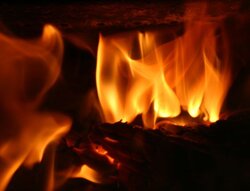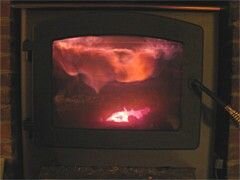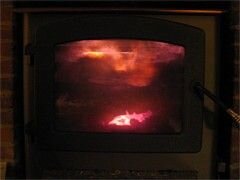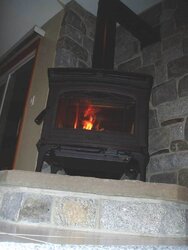Secondary Burn
- Thread starter paulski
- Start date
-
Active since 1995, Hearth.com is THE place on the internet for free information and advice about wood stoves, pellet stoves and other energy saving equipment.
We strive to provide opinions, articles, discussions and history related to Hearth Products and in a more general sense, energy issues.
We promote the EFFICIENT, RESPONSIBLE, CLEAN and SAFE use of all fuels, whether renewable or fossil.
You are using an out of date browser. It may not display this or other websites correctly.
You should upgrade or use an alternative browser.
You should upgrade or use an alternative browser.
- Status
- Not open for further replies.
SlyFerret
Minister of Fire
In older pre-EPA stoves, the only fire you had in the stove was the fire that burned directly on the wood.
It turns out that smoke is unburned fuel going up the chimney. One of the ways that EPA stoves burn so much cleaner than older stoves is that there is a secondary fire inside the stove that burns the smoke in order to take advantage of the energy in the unburnt fuel and release that heat inside your stove.
Some stoves use a baffle to redirect the smoke past a series of tubes in the top of the stoves. These tubes have holes in them that inject pre-heated air into the smoke and re-ignite it. What you get is a beautiful rolling flame at the top of the firebox that floats above the wood.
Catalytic stoves don't use tubes, but instead run the smoke through a box with a superheated honeycomb-like catalyst to ignite and burn the smoke before it leaves the stove. I don't have a cat stove, but from what I understand, they don't give you the light show that the secondary-tube type stoves give you.
In either case, the stove has to be up to operating temperature in order for the secondary combustion to start, or for the catalyst to light off.
The newer EPA stoves are really pretty amazing how much heat they put out with such little fuel. I remember my dad having to constantly feed a very hungry Fisher Mama Bear when I was a kid.
-SF
It turns out that smoke is unburned fuel going up the chimney. One of the ways that EPA stoves burn so much cleaner than older stoves is that there is a secondary fire inside the stove that burns the smoke in order to take advantage of the energy in the unburnt fuel and release that heat inside your stove.
Some stoves use a baffle to redirect the smoke past a series of tubes in the top of the stoves. These tubes have holes in them that inject pre-heated air into the smoke and re-ignite it. What you get is a beautiful rolling flame at the top of the firebox that floats above the wood.
Catalytic stoves don't use tubes, but instead run the smoke through a box with a superheated honeycomb-like catalyst to ignite and burn the smoke before it leaves the stove. I don't have a cat stove, but from what I understand, they don't give you the light show that the secondary-tube type stoves give you.
In either case, the stove has to be up to operating temperature in order for the secondary combustion to start, or for the catalyst to light off.
The newer EPA stoves are really pretty amazing how much heat they put out with such little fuel. I remember my dad having to constantly feed a very hungry Fisher Mama Bear when I was a kid.
-SF
Hanko
Minister of Fire
Im sure you'll get 5000 different opinions on this one, mine is the gas and smoke produced by the fire is ignited again by the secondary air that enters in the top of the stove through the air tubes. Thats about as short and simple as I can do. Be prepared for some very long winded complex explanations
pumiglk
New Member
Is there a difference in secondary burn in strong draft situations? In other words is it harder to ignite the secondary burn in the Fall when the stack differential is less than it might be in the dead of winter? Or if the a stove has intrinsically weak draft will it be less efficient under secondary air only conditions, burning dirty and cooling off. It would seem so but I don't often see Draft and secondary burn discussed at the same time.
It is unbelievable actually. The government mandated lower emissions and it actually turned out to have a couple of other useful side effects. More heat and less smoke from less firewood. Bureaucrats tried to screw up stoves and ended up making them better. You can bet that it wasn't on purpose.
buono fuoco said:Is there a difference in secondary burn in strong draft situations? In other words is it harder to ignite the secondary burn in the Fall when the stack differential is less than it might be in the dead of winter? Or if the a stove has intrinsically weak draft will it be less efficient under secondary air only conditions, burning dirty and cooling off. It would seem so but I don't often see Draft and secondary burn discussed at the same time.
Yep. You need strong draft to pull the air through that maze of secondary air manifolds and tubes/baffles etc. Before I lined my second chimney the little Jotul couldn't get a secondary burn cranked up because of the weak draft.
RedRanger
New Member
BrotherBart said:It is unbelievable actually. The government mandated lower emissions and it actually turned out to have a couple of other useful side effects. More heat and less smoke from less firewood. Bureaucrats tried to screw up stoves and ended up making them better. You can bet that it wasn't on purpose.
Exactly true, and now BB lets just hope that our gov pensions keep on rolling in, yours and mine. And then we will know for sure that they are doing something right. :lol:
sonnyinbc said:...and now BB lets just hope that our gov pensions keep on rolling in, yours and mine. And then we will know for sure that they are doing something right. :lol:
I have another couple of years of eating gruel before mine kicks in. Then I can have bread with the gruel.
SlyFerret
Minister of Fire
Brian VT
Minister of Fire
I got a VC Resolute Acclaim. It isn't installed yet.
It seems my secondary burn will be back in the "combustion package" ?
Does this mean I won't see the Northern Lights to know that I'm reburning ?
It seems my secondary burn will be back in the "combustion package" ?
Does this mean I won't see the Northern Lights to know that I'm reburning ?
Brian VT said:I got a VC Resolute Acclaim. It isn't installed yet.
It seems my secondary burn will be back in the "combustion package" ?
Does this mean I won't see the Northern Lights to know that I'm reburning ?
Yup, if you have one of those ever burn rigs the secondary fire is hiding in the back, BUT you know when it is kicked in and doing good because of a distinct rumble back there. The heat will roll off the back and you may not have to reload it for 4 or 5 hours.
SlyFerret said:MMMM.... Bread and gruel... my favorite!
-SF
I just hope they have comodity peanut butter when I get to retire.
Brian VT
Minister of Fire
I like the sound of that !Saw-dust said:and you may not have to reload it for 4 or 5 hours.
 I didn't buy it to give me a light show, although it looks like it'd be cool to see in action.
I didn't buy it to give me a light show, although it looks like it'd be cool to see in action.Ken45
Minister of Fire
BrotherBart said:It is unbelievable actually. The government mandated lower emissions and it actually turned out to have a couple of other useful side effects. More heat and less smoke from less firewood. Bureaucrats tried to screw up stoves and ended up making them better. You can bet that it wasn't on purpose.
Amazing! Someone was asleep in Washington if they let that one get out the door uncensored! ;-)
Ken
madison
Minister of Fire
smokinj
Minister of Fire
Martin Strand III
New Member
A DILEMMA?
SECONDARY BURN IN A WOOD FIRE starts to occur when volatile gases from the heating wood ignite at a temperature of 600* F in the firebox above the fuel load. At this temperature, the gases are incompletely burned, resulting in smoke and many harmful pollutants going out your chimney. For complete combustion of the gases, and the remaining wood charcoal, a temperature of 1000* - 1100* F is required. (www.epa.gov)
Newer cat wood burning stoves can experience secondary burns at 500* - 700* F in a precious metal converter which is costly, some report "fussy" and requires maintenance.
Newer Phase II non-cat stoves, because of their baffle design above the fire, can have secondary burns in the 600* - 700* F range and above inside the stove. The problem is, this is a HOT fire which approaches overfiring usually requiring damping down incoming air to lower the temperature. The more damping, the lower the temp, the more smoke, pollution, inefficient burn and wasting of fuel.
My view: a new design, with MORE ceramic or masonry (like a firebox liner) on the INSIDE of a metal stove (vs outside like the soapstone/metal stoves) is needed to take the required higher interior temperatures necessary for a cleaner and more efficient burn. So, you think tanks out there, let's start some R & D!
Think about it.
Aye,
Marty
SECONDARY BURN IN A WOOD FIRE starts to occur when volatile gases from the heating wood ignite at a temperature of 600* F in the firebox above the fuel load. At this temperature, the gases are incompletely burned, resulting in smoke and many harmful pollutants going out your chimney. For complete combustion of the gases, and the remaining wood charcoal, a temperature of 1000* - 1100* F is required. (www.epa.gov)
Newer cat wood burning stoves can experience secondary burns at 500* - 700* F in a precious metal converter which is costly, some report "fussy" and requires maintenance.
Newer Phase II non-cat stoves, because of their baffle design above the fire, can have secondary burns in the 600* - 700* F range and above inside the stove. The problem is, this is a HOT fire which approaches overfiring usually requiring damping down incoming air to lower the temperature. The more damping, the lower the temp, the more smoke, pollution, inefficient burn and wasting of fuel.
My view: a new design, with MORE ceramic or masonry (like a firebox liner) on the INSIDE of a metal stove (vs outside like the soapstone/metal stoves) is needed to take the required higher interior temperatures necessary for a cleaner and more efficient burn. So, you think tanks out there, let's start some R & D!
Think about it.
Aye,
Marty
Marty S said:My view: a new design, with MORE ceramic or masonry (like a firebox liner) on the INSIDE of a metal stove (vs outside like the soapstone/metal stoves) is needed to take the required higher interior temperatures necessary for a cleaner and more efficient burn. So, you think tanks out there, let's start some R & D!
I think Corie is already on it Marty. From the picture, it looks like he's starting to see some nice results.
https://www.hearth.com/econtent/index.php/forums/viewthread/23984/
Marty S said:My view: a new design, with MORE ceramic or masonry (like a firebox liner) on the INSIDE of a metal stove (vs outside like the soapstone/metal stoves) is needed to take the required higher interior temperatures necessary for a cleaner and more efficient burn. So, you think tanks out there, let's start some R & D!
Think about it.
Aye,
Marty
Good idea. Who knows? Maybe somebody will come along with one with firebrick lining the firebox on the sides and a ceramic fiber baffle in the top of the firebox. :lol:
smokinj said:Thats Cool!BrotherBart said:A little of the aforementioned secondary burn:
Great balls of fire! That's hot!
It sure is nice to see some burning pictures coming in. We prolly won't be getting the live show for another week or two.
BeGreen said:smokinj said:Thats Cool!BrotherBart said:A little of the aforementioned secondary burn:
Great balls of fire! That's hot!
It sure is nice to see some burning pictures coming in. We prolly won't be getting the live show for another week or two.
Here either. Those are last year. Just warming the stove up before bed time here right now and letting it burn down since it is in the 40's at night.
Martin Strand III
New Member
BeGreen said:Marty S said:My view: a new design, with MORE ceramic or masonry (like a firebox liner) on the INSIDE of a metal stove (vs outside like the soapstone/metal stoves) is needed to take the required higher interior temperatures necessary for a cleaner and more efficient burn. So, you think tanks out there, let's start some R & D!
I think Corie is already on it Marty. From the picture, it looks like he's starting to see some nice results.
https://www.hearth.com/econtent/index.php/forums/viewthread/23984/
I read the thread. Corie is pretty tight lipped about it. How do you know it's lots of masonry inside and metal outside just from the picture and a few scant comments? How can you see "nice results" in that picture? I sure can't but maybe it's just me. Could be an oil drum fire... I'm not impressed by the photo or the secrecy.
Aye,
Marty
BJ64
Minister of Fire
Marty S said:BeGreen said:Marty S said:My view: a new design, with MORE ceramic or masonry (like a firebox liner) on the INSIDE of a metal stove (vs outside like the soapstone/metal stoves) is needed to take the required higher interior temperatures necessary for a cleaner and more efficient burn. So, you think tanks out there, let's start some R & D!
I think Corie is already on it Marty. From the picture, it looks like he's starting to see some nice results.
https://www.hearth.com/econtent/index.php/forums/viewthread/23984/
I read the thread. Corie is pretty tight lipped about it. How do you know it's lots of masonry inside and metal outside just from the picture and a few scant comments? How can you see "nice results" in that picture? I sure can't but maybe it's just me. Could be an oil drum fire... I'm not impressed by the photo or the secrecy.
Aye,
Marty
I can understand how you feel. You may already know but for the benefit of the other readers. Corie has a product development position at England Stove Co. I may need corrected on his exact position and the company's name. At any rate, he is well aware of the matter and understands the limitations of the materials in the stove. Best of all, he is doing things about it
 . Of course that takes time and money and the secrecy is to protect the company's investment in trying to get a better product to market. I'm sure you figured that much out.
. Of course that takes time and money and the secrecy is to protect the company's investment in trying to get a better product to market. I'm sure you figured that much out.I'm rather new here, but from what I gather, Corie is quite innovative. I don't think he would be would post a picture of a fire if it was the same old same we are used to.
I agree it was a vague picture, but if we knew enough to understand what we was looking at, then the pic might be much more revealing. I suppose it might be like trying to interpret art.
- Status
- Not open for further replies.
Similar threads
- Replies
- 73
- Views
- 5K
- Replies
- 8
- Views
- 2K
- Replies
- 6
- Views
- 453
- Replies
- 4
- Views
- 458





